تتبع المساعدات النقدية والقسائم
لتزم الموقعون على الصفقة الكبرى بزيادة استخدام المساعدات النقدية والقسائم، واستخدام علامات مشتركة لقياس هذه الزيادات. على الرغم من بدء تتبع حجم المساعدات النقدية والقسائم بشكل أكثر فعالية، إلّا أنه ثمة تحديات تقنية وسياسية. وهذا يضم ما يلي:
- تحديد البيانات التي يجب جمعها وطريقة القيام بذلك
- ضمان الالتزام باستخدام فئات وأنظمة البيانات
- معالجة أوجه القصور في أنظمة إعداد التقارير الحالية التي لم يتم تصميمها في كثير من الأحيان لتضمين أو تفصيل النقد والقسائم والطرائق الأخرى
- التوصل إلى اتفاق مشترك حول الفئات المعيارية للإبلاغ لتجنب البيانات غير الكاملة وغير المتسقة.
الأولويات الحالية
شاركت شبكة CALP، من عام 2017 إلى عام 2019، في قيادة مسار العمل الفرعي للصفقة الكبرى بشأن تتبع المساعدات النقدية والقسائم مع المديرية العامة للحماية المدنية الأوروبية وعمليات المساعدة الإنسانية، بهدف رئيسي يتمثل في الاتفاق على الحد الأدنى من المتطلبات لتتبع المساعدات النقدية والقسائم. يتضمن ذلك دمج المساعدات النقدية والقسائم في أنظمة ومنصات إعداد التقارير الرئيسية المشتركة بين الوكالات، أي خدمة التتبع المالي التابعة لمكتب تنسيق الشؤون الإنسانية ووحدة مشروع دورة البرمجة الإنسانية، ومعيار بيانات مبادرة الشفافية الخاصة بالمعونة الدولية، وإعداد تقارير 3W (وهي تتمثل في من الذي سيفعل وماذا سيفعل وأين سيفعل). تم الآن دمج مسار العمل الفرعي الخاص بتتبع المساعدات النقدية والقسائم في مسار العمل الفرعي للكفاءة والفعالية والقيمة مقابل المال، والذي ستستمر شبكة CALP في قيادته.
Featured content

Tracking Cash & Voucher Assistance Workshop – Part 2: Report
Presentation
Do you want to read the latest on discussions on how to best track cash and voucher assistance in global interagency reporting systems? The CALP Network and ECHO have just released Tracking Cash & Voucher Assistance Workshop – Part 2: Report. Key recommendations emerging from the workshop are summarized below. These will be used in the coming months as a basis to develop guidance for...

Measuring Cash Transfer Programming – Scoping study
Report
This scoping study explores technical and policy issues that are constraining progress towards better measurement and reporting of Cash Transfer Programming (CTP) and addresses these to identify ways forward. The study was developed with the following objectives: • Map and document how different implementing agencies and donors are measuring cash and voucher programming data at the...

Tracking Cash and Voucher Assistance: Agreements, recommendations and minimum requirements from the Grand Bargain cash workstream
Guidelines and Tools
This document comprises the key outputs of the work undertaken through the Tracking Cash and Voucher Assistance (CVA) Working Group from 2017 to 2019. The Tracking CVA Working Group was established as the
platform for engagement and decision-making for the sub-workstream on Tracking CVA, which is part of the Grand Bargain Cash Workstream. The Tracking CVA sub-workstream was co-led by the the...
Thematic lead
Latest
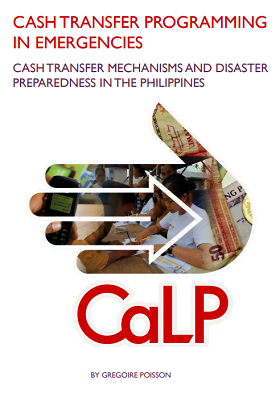
Cash transfer mechanisms and disaster preparedness in the Philippines
Report
The use of cash to deliver assistance in case of humanitarian emergency remains a relatively new approach in the Philippines, and aid agencies are at the early stages of developing guidelines, policies and organizational capacity to implement cash projects. Project managers lack support and guidance with...
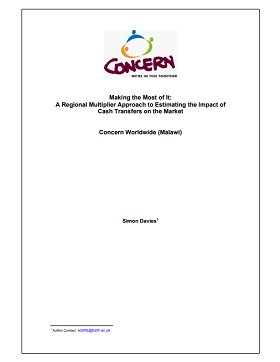
Making the most of it: A regional multiplier approach to estimating the impact of cash transfers on the market
Case Study
This study examines the regional multiplier effect resulting from Concern’s emergency cash transfer programme in Dowa district in Malawi, which experienced a food deficit in 2006. It uses a Reduced Social Accounting Matrix to calculate and analyse the impact of the cash transfers on different economic...

IASC Evaluation of the Humanitarian Response in South Central Somalia 2005-2010
Case Study
This independent report presented by DARA confirms that humanitarian aid in Somalia has saved thousands of lives between the years 2005 to 2010. The report is based on an evaluation of the humanitarian response in south-central Somalia and is one of the most comprehensive evaluations of aid in Somalia...
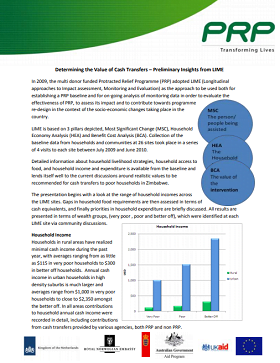
Determining the Value of Cash Transfers – Preliminary Insights from LIME
Report
In 2009, the multi donor funded Protracted Relief Programme (PRP) adopted LIME (Longitudinal approaches to Impact assessment, Monitoring and Evaluation) as the approach to be used both for establishing a PRP baseline and for on-going analysis of monitoring data in order to evaluate the effectiveness of...

Voucher Fairs: A Quick Delivery Guide (screen version)
Guidelines and Tools
A Quick Delivery Guide to using voucher fairs to implement a market-based emergency response. Prepared as a practical tool, this guide provides a brief synthesis of the necessary preconditions and advantages and disadvantages of using voucher fairs. It also provides practical implementation tips.

Support to Economic Recovery of Urban Households in Karoi town, Zimbabwe (the CALP Network Case Study)
Report
In the urban area of Karoi, Zimbabwe, Save the Children combined cash for work with livelihoods support to meet the immediate food needs and support the economic recovery of poor families. The project used smart cards to transfer cash to beneficiaries, which proved to be an appropriate payment...
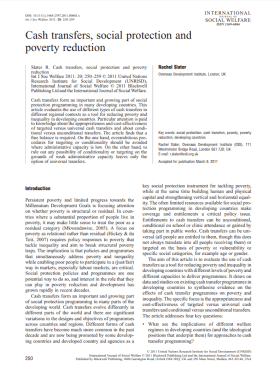
Cash Transfers, Social Protection and Poverty Reduction
Policy paper
Cash transfers form an important and growing part of social protection programming in many developing countries. This article evaluates the use of different types of cash transfers in different regional contexts as a tool for reducing poverty and inequality in developing countries. Particular attention is...

Public Health Agencies and Cash Transfer Programmes: Making the case for greater involvement
Policy paper
This report examines the case for greater involvement by public health agencies in cash transfer schemes, a form of welfare assistance. It seeks to identify opportunities, obstacles and actions that might support greater involvement. The issue arises because cash transfer schemes are an increasingly...

Trading in Turbulent Times: Smallholder maize marketing in the Southern Highlands, Tanzania
Report
The short-run effects of the 2007/2008 global food crisis on semisubsistence farmers’ well-being in low-income countries depends on whether they are net sellers or net buyers of the affected commodities. Realizing that farmers face volatile prices over the course of an agricultural year, this study...

An Evaluation of Save the Children’s Cash Transfer Project in Aweil East County, Northern Bahr el Ghazal State, South Sudan
Report
Since April 2009, Save the Children have been implementing an ECHO-funded cash transfer project in Baac Payam, Aweil East County. The specific objective of this project has been to improve dietary diversity and nutritional outcomes among the targeted households that inhabit a part of Sudan which has some...
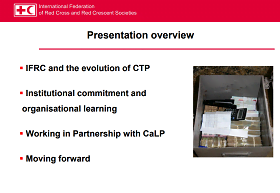
IFRC and the evolution of CTP
Presentation
An IFRC presentation covering the following topics: IFRC and the evolution of CTP Institutional commitment and organisational learning Working in Partnership with the CALP Network Moving forward
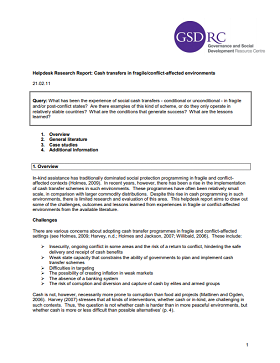
Helpdesk Research Report: Cash Transfers in Fragile/Conflict-Affected Environments
Report
In-kind assistance has traditionally dominated social protection programming in fragile and conflict-affected contexts (Holmes, 2009). In recent years, however, there has been a rise in the implementation of cash transfer schemes in such environments. These programmes have often been relatively small...

Emergency Livelihood Recovery Intervention (ELRI): Fafi District – Garissa County – North Eastern Kenya
Report
The Emergency Livelihood Recovery Intervention (ELRI) was implemented by Horn Relief with funding from OFDA. The Emergency Livelihood Recovery Intervention (ELRI) took place between January 2010 and April 2011; it was designed to address the immediate food security needs of the drought-stricken population...
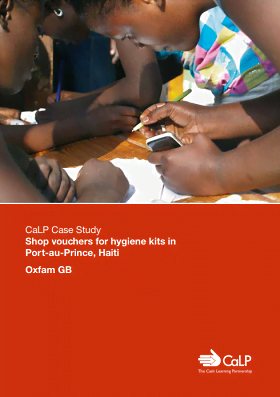
Shop vouchers for hygiene kits in Port-au-Prince, Haiti (the CALP Network Case Study)
Report
In the aftermath of the 2010 Haiti earthquake, Oxfam’s Public Health Promotion team used a voucher programme to provide beneficiaries with essential hygiene items through local shops. The voucher system was chosen so that beneficiaries could access hygiene items in a normal and dignified way, and in...

Protection
Guidelines and Tools
Protection mainstreaming is a practical, efficient and effective means to maximise the protective impact of aid programming. Through incorporating protection principles into aid design and delivery, humanitarian actors can:
Promote the human rights of affected populations
Enhance affected populations’...

Results of the Market Information and Food Insecurity Response Analysis (MIFIRA) framework conducted in two locations in Kenya
Case Study
This research paper shows the results of the MIFIRA framework which was applied through a Catholic Relief Services programme in one urban and one rural location in Kenya. The difference between urban and rural food security is explained and then the findings of the two case studies are described in...
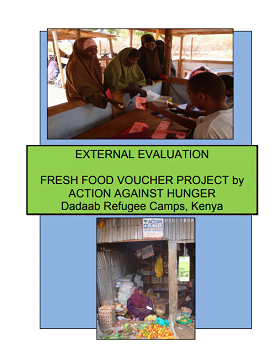
External Evaluation: Fresh Food Voucher Project by Action Against Hunger in Dadaab Refugee Camps, Kenya
Report
The town of Dadaab in North Eastern Kenya is home to three refugee camps: Hagadera, Dagahaley and Ifo hosting over 240,000 people. The camps were established in mid-1992 after the closure of the Liboi camp, which was too close to the Kenya/Somali border to ensure adequate security. Continued insecurity in...
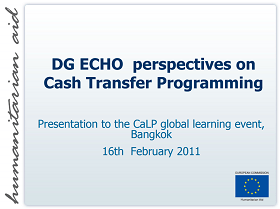
DG ECHO perspectives on Cash Transfer Programming
Presentation
A presentation accompanying the CALP Network global learning event, Bangkok 16th February 2011, covering the following topics: DG ECHO position on the use of Cash &Vouchers (C&V) Trends in funding C&V projects Using C&V at scale: the case of Haiti Capacity building priorities
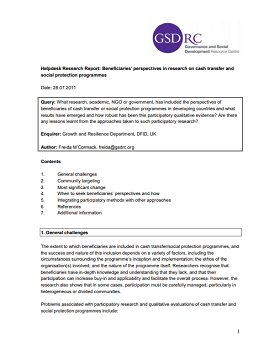
Helpdesk Research Report: Beneficiaries’ perspectives in research on cash transfer and social protection programmes
Report
Query: What research, academic, NGO or government, has included the perspectives of beneficiaries of cash transfer or social protection programmes in developing countries and what results have emerged and how robust has been this participatory qualitative evidence? Are there any lessons learnt from the...
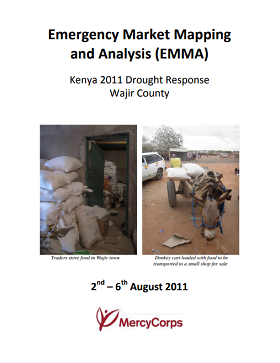
EMMA – Wajir, Kenya
Report
Mercy Corps conducted an adapted Emergency Market Mapping and Analysis (EMMA) assessment in Wajir County of Kenya from 2-6 August 2011. The assessment was organized as a response to the hunger crisis resulting from the worst drought in the region in the last 60 years. The EMMA methodology was adapted...



